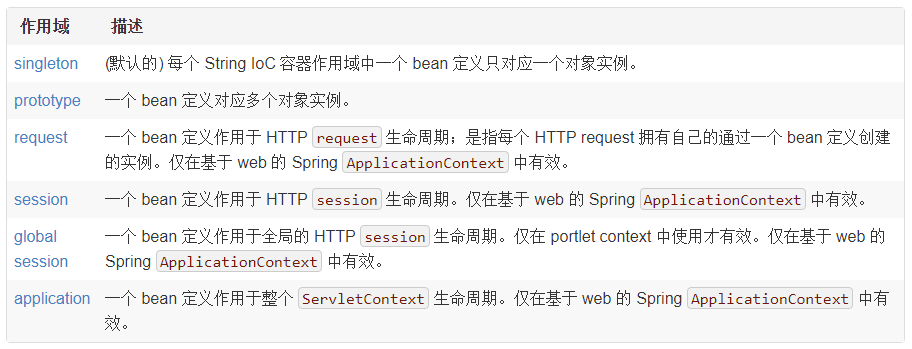【Java框架】控制反转IOC(Inversion of Control)
1. IOC的概念
控制反转IoC(Inversion of Control)是一种设计思想,而DI(依赖注入)是实现IoC的一种方法。在没有使用IOC的程序中,对象间的依赖关系是靠硬编码的方式实现的。引入IOC后对象的创建由程序自己控制的,控制反转即将对象的创建交给第三方,个人认为所谓控制反转就是:获得依赖对象的方式反转了。

IoC是Spring框架的核心内容,在IOC容器中一切对象皆为Bean组件。IOC容器通过读取XML配置文件中的Bean信息,产生每个Bean实例。也可以使用注解,新版本的Spring也可以零配置实现IoC。
2. 使用XML配置文件实现依赖注入
/**人*/ public abstract class Person { public String name; }
/**学生*/ public class Student extends Person { /**身高*/ public int height; /**有参构造方法*/ public Student(String name,int height){ this.name=name; this.height=height; } @Override public String toString() { return "Student{" + "height=" + height+",name="+name +'}'; } }
import org.springframework.context.ApplicationContext; import org.springframework.context.support.ClassPathXmlApplicationContext; public class School { public static void main(String[] args) { //IoC容器 ApplicationContext ctx=new ClassPathXmlApplicationContext("beans02.xml"); //从容器中获取对象 Person tom=ctx.getBean("tom",Person.class); System.out.println(tom); } }
2.1 通过参数名来注入
<?xml version="1.0" encoding="UTF-8"?> <beans xmlns="http://www.springframework.org/schema/beans" xmlns:xsi="http://www.w3.org/2001/XMLSchema-instance" xsi:schemaLocation="http://www.springframework.org/schema/beans http://www.springframework.org/schema/beans/spring-beans.xsd"> <bean id="tom" class="spring02.Student"> <constructor-arg name="name" value="张柏川"></constructor-arg> <constructor-arg name="height" value="195"></constructor-arg> </bean> </beans>
2.2 通过参数下标来注入
<bean id="rose" class="spring02.Student"> <constructor-arg index="0" value="张柏芝"></constructor-arg> <constructor-arg index="1" value="196"></constructor-arg> </bean>
2.3 通过属性赋值
<bean id="jack" class="spring02.Student"> <property name="name" value="张三"></property > <property name="height" value="195"></property > </bean>
注意:这种通过property 注入的方式,只能对有构造器(即有set和get方法)的属性注入,对与没有构造器的属性不能用这种方式注入
特殊情况:若注入的属性为引用类型,则通过ref指定属性值
Student.java
/**学生*/ public class Student { /**姓名*/ String name; /**身高*/ public int height; /**地址*/ public Address address; /**有参构造方法*/ public Student(String name,int height){ this.name=name; this.height=height; } /**有参构造方法*/ public Student(String name,int height,Address address){ this.name=name; this.height=height; this.address=address; } @Override public String toString() { return "Student{" + "height=" + height+",name="+name +'}'+address; } }
Address.java
/**地址*/ public class Address { /**国家*/ private String country; /**城市*/ private String city; public Address() { } public Address(String country, String city) { this.country = country; this.city = city; } @Override public String toString() { return "Address{" + "country='" + country + '\'' + ", city='" + city + '\'' + '}'; } public String getCountry() { return country; } public void setCountry(String country) { this.country = country; } public String getCity() { return city; } public void setCity(String city) { this.city = city; } }
通过配置文件注入引用类型属性
<?xml version="1.0" encoding="UTF-8"?> <beans xmlns="http://www.springframework.org/schema/beans" xmlns:xsi="http://www.w3.org/2001/XMLSchema-instance" xsi:schemaLocation="http://www.springframework.org/schema/beans http://www.springframework.org/schema/beans/spring-beans.xsd"> <bean name="zhuhai" class="spring02.Address"> <property name="country" value="中国"></property> <property name="city" value="珠海"></property> </bean> <bean id="tom" class="spring02.Student"> <constructor-arg name="name" value="张柏川"></constructor-arg> <constructor-arg name="height" value="195"></constructor-arg> <constructor-arg name="address" ref="zhuhai"></constructor-arg> </bean> <bean id="rose" class="spring02.Student"> <constructor-arg index="0" value="张柏芝"></constructor-arg> <constructor-arg index="1" value="196"></constructor-arg> <constructor-arg index="2" ref="zhuhai"></constructor-arg> </bean> </beans>
测试代码:
package spring02; import org.springframework.context.ApplicationContext; import org.springframework.context.support.ClassPathXmlApplicationContext; public class School { public static void main(String[] args) { //IoC容器 ApplicationContext ctx=new ClassPathXmlApplicationContext("bookbean01.xml","beans02.xml"); //从容器中获取对象 Person tom=ctx.getBean("tom",Person.class); Person rose=ctx.getBean("rose",Person.class); //Address zhuhai=ctx.getBean("zhuhai",Address.class); System.out.println(tom); System.out.println(rose); } }
2.4 scope属性控制从容器中取回对象的作用域
从容器中取回的对象默认是单例的
Person roseA=ctx.getBean("rose",Person.class);
Person roseB=ctx.getBean("rose",Person.class);
//Address zhuhai=ctx.getBean("zhuhai",Address.class);
System.out.println(tom);
System.out.println(roseA==roseB);
运行结果:

scope属性可取值如下:

scope属性取值prototype的实例:
<bean id="rose" class="spring02.Student" scope="prototype"> <constructor-arg index="0" value="张柏芝"></constructor-arg> <constructor-arg index="1" value="196"></constructor-arg> <constructor-arg index="2" ref="zhuhai"></constructor-arg> </bean>
//从容器中获取对象 Person tom=ctx.getBean("tom",Person.class); Person roseA=ctx.getBean("rose",Person.class); Person roseB=ctx.getBean("rose",Person.class); //Address zhuhai=ctx.getBean("zhuhai",Address.class); System.out.println(tom); System.out.println(roseA==roseB);
运行结果:

2.5 lazy-init属性控制Bean的延迟实例化
ApplicationContext默认是在启动时将所有 singleton bean提前实例化。 通常这样的提前实例化方式是好事,因为配置中或者运行环境的错误就会被立刻发现,否则可能要花几个小时甚至几天。如果你不想这样,你可以将单例bean定义为延迟加载防止它提前实例化。延迟初始化bean会告诉Ioc容器在第一次需要的时候才实例化而不是在容器启动时就实例化。
实例:
<bean id="lazytom" class="spring_IoC.dao.Student" lazy-init="true" scope="prototype">
<constructor-arg name="name" value="张柏川"></constructor-arg>
<constructor-arg name="height" value="195"></constructor-arg>
</bean>
public static void main(String[] args) { //IoC容器 ApplicationContext ctx =new ClassPathXmlApplicationContext("applicationContext.xml"); try { Thread.sleep(2000); //从容器中获取对象 Person tom1=ctx.getBean("lazytom",Person.class); System.out.println("tom1初始化了"); Thread.sleep(2000); Person tom2=ctx.getBean("lazytom",Person.class); System.out.println("tom2初始化了"); System.out.println(tom1==tom2); } catch (InterruptedException e) { e.printStackTrace(); } }
结果:
tom1初始化了 tom2初始化了 false


